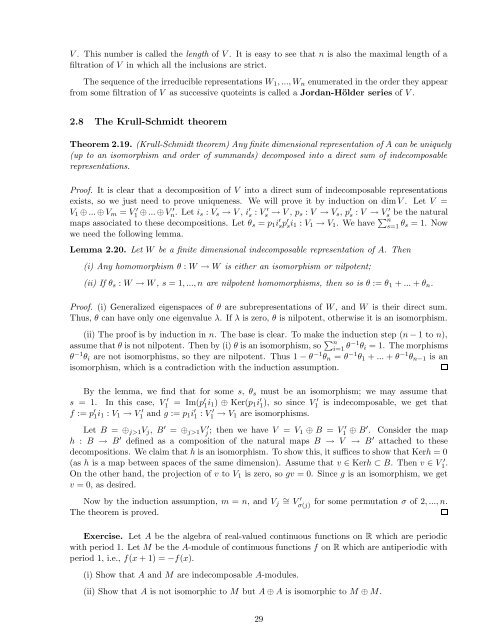Lecture notes for Introduction to Representation Theory
Lecture notes for Introduction to Representation Theory
Lecture notes for Introduction to Representation Theory
Create successful ePaper yourself
Turn your PDF publications into a flip-book with our unique Google optimized e-Paper software.
V . This number is called the length of V . It is easy <strong>to</strong> see that n is also the maximal length of a<br />
filtration of V in which all the inclusions are strict.<br />
The sequence of the irreducible representations W 1 , ..., W n enumerated in the order they appear<br />
from some filtration of V as successive quoteints is called a Jordan-Hölder series of V .<br />
2.8 The Krull-Schmidt theorem<br />
Theorem 2.19. (Krull-Schmidt theorem) Any finite dimensional representation of A can be uniquely<br />
(up <strong>to</strong> an isomorphism and order of summands) decomposed in<strong>to</strong> a direct sum of indecomposable<br />
representations.<br />
Proof. It is clear that a decomposition of V in<strong>to</strong> a direct sum of indecomposable representations<br />
exists, so we just need <strong>to</strong> prove uniqueness. We will prove it by induction on dim V . Let V =<br />
V 1 ... V m = V 1 ... V . Let i s : V s ⊃ V , i : V ⊃ V , p s : V ⊃ V s , p : V ⊃ V be the natural<br />
n s s s s<br />
<br />
maps associated <strong>to</strong> these decompositions. Let χ s = p 1 i p i 1 : V 1 ⊃ V 1 . We have ⎨ n<br />
s s s=1 χ s = 1. Now<br />
we need the following lemma.<br />
Lemma 2.20. Let W be a finite dimensional indecomposable representation of A. Then<br />
(i) Any homomorphism χ : W ⊃ W is either an isomorphism or nilpotent;<br />
(ii) If χ s : W ⊃ W , s = 1, ..., n are nilpotent homomorphisms, then so is χ := χ 1 + ... + χ n .<br />
Proof. (i) Generalized eigenspaces of χ are subrepresentations of W , and W is their direct sum.<br />
Thus, χ can have only one eigenvalue ∂. If ∂ is zero, χ is nilpotent, otherwise it is an isomorphism.<br />
(ii) The proof is by induction in n. The base is clear. To make the induction step (n − 1 <strong>to</strong> n),<br />
assume that χ is not nilpotent. Then by (i) χ is an isomorphism, so ⎨ n<br />
i=1 χ−1 χ i = 1. The morphisms<br />
χ −1 χ i are not isomorphisms, so they are nilpotent. Thus 1 − χ −1 χ n = χ −1 χ 1 + ... + χ −1 χ n−1 is an<br />
isomorphism, which is a contradiction with the induction assumption.<br />
By the lemma, we find that <strong>for</strong> some s, χ s must be an isomorphism; we may assume that<br />
s = 1. In this case, V 1<br />
<br />
= Im(p 1 i 1 ) Ker(p 1 i 1 ), so since V 1<br />
<br />
is indecomposable, we get that<br />
f := p 1 i 1 : V 1 ⊃ V 1 and g := p 1 i 1<br />
<br />
: V 1 ⊃ V 1 are isomorphisms.<br />
Let B = j>1 V j , B = j>1 V j ; then we have V = V 1 B = V 1 B . Consider the map<br />
h : B ⊃ B defined as a composition of the natural maps B ⊃ V ⊃ B attached <strong>to</strong> these<br />
decompositions. We claim that h is an isomorphism. To show this, it suffices <strong>to</strong> show that Kerh = 0<br />
(as h is a map between spaces of the same dimension). Assume that v Kerh → B. Then v V 1 .<br />
On the other hand, the projection of v <strong>to</strong> V 1 is zero, so gv = 0. Since g is an isomorphism, we get<br />
v = 0, as desired.<br />
Now by the induction assumption, m = n, and V j<br />
∪ = Vε<br />
<br />
(j)<br />
<strong>for</strong> some permutation ε of 2, ..., n.<br />
The theorem is proved.<br />
Exercise. Let A be the algebra of real-valued continuous functions on R which are periodic<br />
with period 1. Let M be the A-module of continuous functions f on R which are antiperiodic with<br />
period 1, i.e., f(x + 1) = −f(x).<br />
(i) Show that A and M are indecomposable A-modules.<br />
(ii) Show that A is not isomorphic <strong>to</strong> M but A A is isomorphic <strong>to</strong> M M.<br />
29

















